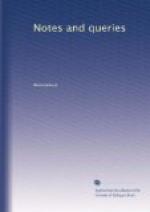Of these. Mary Burdett married, first, Richard Pilkington, and second, Sir T. Beaumont, of Whitby: and another sister married—Ramsden. No issue of either are recorded. The third sister, Elizabeth Burdett, married, at Hoyland, 6th Feb., 1636, the Rev. Daniel Clark, A.M., and died 27th Aug., 1679, at Fenney-Compton. Their great-grandson and sole male representative was the late Joseph Clark of Northampton, whose descendants also quarter Hardwick.
ELIZABETH HARDWICK, the next daughter, was the celebrated Countess of Shrewsbury. Her representatives are all noble, and their pedigrees may be found in the Peerages. They are—
1. The Duke of Devonshire, representing Wm. Cavendish, first earl.
Certain descendants of Sir Charles Cavendish, of Welbeck Abbey, or rather of his grandson, Henry, second Duke of Newcastle, namely,
2. The Duke of Portland, representing Margaret Pelham, the Duke’s eldest coheir;
3. The Marquis of Salisbury from Catherine, and second coheir;
4. The Earl De la Warr; and
5. The Earl of Aboyne, are the coheirs of Sir Charles Cope, Baronet, of Orton; who represented Arabella, Countess of Sunderland, third coheir. These five all quarter Hardwick.
ALICE HARDWICK, next daughter, married Francis Hercy, according to some pedigrees. No issue recorded.
There are therefore descendants certainly known of only two of the children of John Hardwick. Possibly some of your correspondents can supply those of Wingfield and Hercy.
The crest and arms of the Hardwicks may be found in Edmondson. They only quartered Pynchbeke. I am not aware of any motto. {284}
Miss Costello, and other biographers of the Countess of Shrewsbury, have quite overlooked all the descendants of her sisters. Possibly, should these lines meet the eye of the Duke of Devonshire, who possesses the estates and papers of the Hardwicks, it may lead to more particulars concerning the family being made public.
ERMINE.
Torquay.
Quotations in Bishop Andrewes (Vol. ii., p. 245.).—
“Minutuli et patellares Dei.”
is from Plautus:
“Di me omnes magni minutique et
patellarii.”
Cistell. II. 1. 46.
and
“Sed quae de septem totum circumspicit
orbem
Collibus, imperii Roma Deumque locus.”
is from Ovid (Trist. I. 5. 69.).
J.E.B MAYOR.
Marlborough College.
The Sun Feminine in English (Vol. ii., p. 21).—MR. COX may perhaps be pleased to learn why the northern nations made the sun feminine. The ancient Germans and Saxons—




